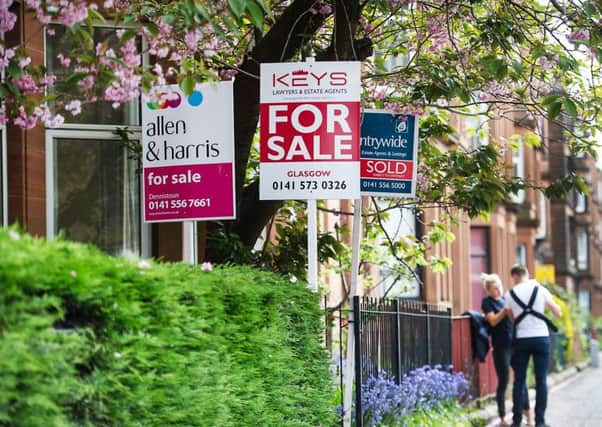Hit to house prices blamed on '˜sluggish' Scottish economy


Data released by Registers of Scotland (ROS) found prices north of the Border rose by 4.3 per cent over the 12 months to August to £144,561, up from £138,564 in that month the previous year.
The UK average climbed by 8.4 per cent over the same period to £218,964.
Advertisement
Hide AdAdvertisement
Hide AdLast night David Bell, professor of economics at the University of Stirling, blamed the change on the Scottish economy falling behind that of the UK since the last recession.
He said Scotland’s housing market also reflected caution following June’s vote to leave the European Union, with potential buyers holding back from making financial commitments.
He said: “The oil industry is an obvious problem for Scotland and the Scottish economy has taken longer to come out of recession than the rest of the UK. Scotland is particularly dependent on financial services and that has not had a good time since RBS and the recession.
“Also, while Scotland is getting some inward investment this has not had a huge effect on the Scottish economy in recent years. All of this contributes to the economy being sluggish,
“Brexit and the 2014 independence referendum have caused uncertainty and make people cautious.
“The full effects of Brexit aren’t known yet, and the key statistics take a while to be collected, but we do know that the effects build up and if someone decides not to invest, in steel for example, this makes its way down the chain of buyers.”
He added: “While the Scottish Government’s commitment to building more houses is good for the economy, whether this will have an effect on house prices and sales is yet to be seen.”
Figures show there was a 1.3 per cent increase in house prices on the previous month, according to the UK House Price Index Scotland for August 2016. The biggest price increase over the last year was in East Renfrewshire, where the average price increased by 12.7 per cent to £219,511. Aberdeen saw the biggest decrease, with prices dropping by 8.7 per cent to £175,922.
Advertisement
Hide AdAdvertisement
Hide AdThere were 8,620 residential sales across Scotland in June 2016, down 7.4 per cent on the previous year but up 20.9 per cent on the previous month.
The top five local authorities in terms of sales volumes were the City of Edinburgh, Glasgow City, South Lanarkshire, Fife and North Lanarkshire.
Overall volumes fell in June by 7.4 per cent year-on-year but were up by 20.9 per cent on the previous month.
Prof Bell said Scotland’s housing market was likely to be affected by uncertainty for some time. He said: “House buyers are likely to hold back, though in theory the lower interest rates should be offsetting that uncertainty.
“The Scottish Government has a commitment to building houses which is good for the economy but we cannot be sure what the effect would be on house prices.
“We will not know until the Chancellor’s Autumn Statement on 23 Nonmember if the we are going to continue with austerity or if the economy will relax somewhat.”
Kenny Crawford, ROS director of commercial services, said: “In the five months since the House Price Index was first published in June 2016, the City of Aberdeen has shown each month the biggest annual percentage decrease in average price of all of Scotland’s local authority areas.
“Overall, average prices in the area have fallen consistently over the last 15 months when comparing monthly average price figures with the figures for the same month in the previous year.”
Advertisement
Hide AdAdvertisement
Hide AdMr Crawford added: “We still may be seeing some impact from changes in Land and Buildings Transaction Tax that came into effect on 1 April, 2016 for additional dwellings, such as second homes and buy-to-let properties.
“These changes are likely to have contributed to the significant increase in volumes seen in March and to the subsequent lower volumes that have followed in April, May and June.”
However, Maria Botha-Lopez, business analyst at the Edinburgh Solicitors’ Property Centre, said that the figures were a reflection of the different property markets north and south of the Border.
“Since the introduction of the UK House Price Index we have been seeing a similar difference in the pattern of growth between average selling prices in Scotland and England, which is indicative of two different property markets, as has traditionally been the case.
“It should also be kept in mind that the English property market is fuelled by demand in London and the south-east, where average selling prices in London is £488,908. In Edinburgh, Scotland’s most expensive region, the average selling price is £226,454. Overall Scottish average selling prices are comparable to the north of England.”